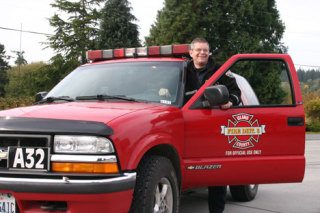Emergency teams pick up 90 percent of FD3 calls
FREELAND — You’re in the parking lot of a grocery store. In drives a bright-red 1998 Chevy SUV with a light bar on top and the clearly-marked insignia of Island County Fire District 3.
A guy gets out, dressed in a casual uniform, carrying his environmentally friendly cloth grocery bag, checking out his shopping list.
Whoa, what’s this? Driving the taxpayers’ vehicle around on personal errands? Time to phone the fire chief.
Wait, don’t do it. This guy could be just a short drive away from saving someone’s life.
He’s part of the fire district’s MERV program. MERV stands for Medical Emergency Response Vehicle.
The program, started in 2001, gets medical help in a hurry to 911 emergencies on South Whidbey.
“There are people on this island who can thank their lucky stars one of these vehicles arrived,” said Paul Busch, assistant chief in charge of special services for the fire district.
The district has three MERV four-wheel-drive vehicles, all equipped to handle medical problems.
One is stationed at the Langley fire station. The other two are at the Freeland and Clinton stations, and can be checked out by volunteer emergency medical technicians (EMTs) for three hours or up to three days.
When an EMT checks out a MERV, he or she is on call the entire time. EMTs wear informal district uniforms and drive the vehicles wherever they go, day or night.
They are required to respond immediately to all medical calls in their service areas.
“If they’re at a restaurant and their dinner is just put in front of them and they get a call, they’re gone,” Busch said.
Connie Shields, supervisor of the district’s emergency medical services division, said the district is divided into two MERV areas to lessen the distance of a first response.
One area is from north of Freeland to Bayview Road, the other from Bayview Road to Clinton.
“The smaller the response area, the faster a MERV gets to your emergency,” Shields said.
She said that in January, the Langley MERV will be available for volunteer check-out, dividing the response area into three sections instead of two and further reducing the areas of individual coverage.
“MERVs are invaluable to the level of emergency care provided to our community,” Shields said. “They can be on the scene providing care and stabilizing patients while the ambulance is still enroute.”
District 3 covers an area of more than 66 square miles, including 57 miles of shoreline. Manned by a small paid staff and about 80 volunteers, 55 of which are certified EMTs, the district has six stations; Freeland, Maxwelton, Saratoga, Langley, Clinton and Bayview.
In most cases, ambulances from Whidbey General Hospital transport the injured, but the MERVs have room for a stretcher if necessary, Shields said.
The hospital has assigned two ambulances staffed by EMTs and paramedics to cover South Whidbey, Shields said. When both are in service, a third ambulance can be dispatched, if available, from Coupeville or Oak Harbor, she said.
But because of the size of the district, it may take 20 minutes for an ambulance to respond, she said. That’s where the MERVs come in.
The EMTs must complete 150 hours of study, including patient contact and emergency driving class. To become licensed by the state, they are required to pass stringent written and practical-skills exams.
“They also continue weekly training and are required to recertify with the state every three years,” Shields said.
Kevin Craig, of Clinton, is into his third year as a MERV volunteer EMT.
“It’s a great program for helping out the residents of the island,” he said.
Craig manages Lakeside Bible Camp at Deer Lake, making him available to the district most days. He said he has responded to emergency calls ranging from someone who has fallen and needs help getting up, to multi-vehicle collisions whose victims needed CPR.
“I think it’s great we can respond this way,” Craig said. “We can be there real quick.”
He said he and other EMT volunteers keep medical-emergency bags in their personal vehicles, in which they often respond if they don’t have a MERV.
Shields said the MERV program averages about five calls per day, including medical calls, fires and vehicle accidents. She said the district responded to 1,398 calls through September, and the MERVs were dispatched to about 90 percent of them.
Shields said the two MERVs available for check-out have been staffed for more than 12,000 hours through September.
She said the three Chevy Blazers are 10 years old, and are earmarked to be replaced next year by modified Honda Pilot SUVs.
Shields has been an EMT since 1979 on Lopez Island in the San Juans. She became a District 3 volunteer in 1984, and a paid staff member a year ago. She is a senior state EMT instructor, and supervises all the District 3 EMT training.
“We’re always looking for more volunteers,” she added.
Shields said a recruitment campaign to get more firefighter and EMT volunteers will kick off with an informational pancake breakfast from 9 a.m. to noon Saturday, Nov. 8 at the Freeland station, 5535 Cameron Road.
For information, call 321-1533 or visit www.icfd3.com.
Roy Jacobson can be reached at 221-5300 or rjacobson@southwhidbeyrecord.com.



